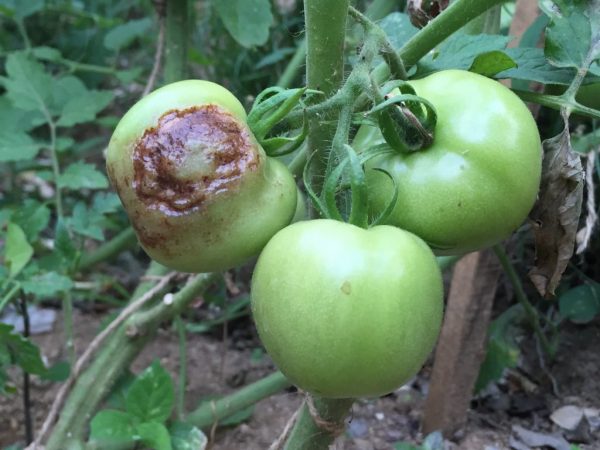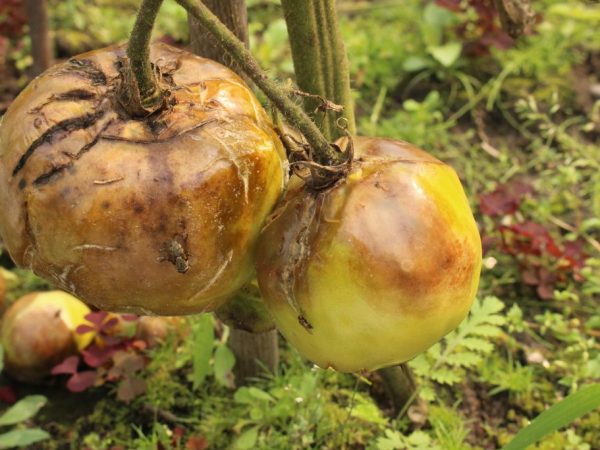Why do tomatoes blacken on a bush

Tomatoes turn black on the bush
If the tomatoes turn black on the bush, this means that the plant is experiencing discomfort, more often it is a lack of nutrition or a violation of agricultural practices. In addition to the fact that such a state of the crop is already a disaster in itself, there is also a risk that the disease will pass into the soil and infect new plantings.
Causes of fruit blackening
Black spots on vegetables may indicate that a disease has struck the plants. The second reason for this reaction of tomatoes may be improper care of the bushes. Darkening is the first symptom that should prompt gardeners to take action.
Tatiana Orlova (Candidate of Agricultural Sciences):
Diseases of tomato can be infectious, caused by various pathogens and physiological, due to the violation of any processes in plants.
Diseases
Tomatoes often begin to turn black due to fungal infection.
They especially breed in greenhouses and hotbeds. Moisture and warmth are beneficial conditions for these pathogens. The disease can spread from the crops that grow nearby. Also, fungal spores are carried by the wind in the open field from other areas. They can be found in the soil after infected crops that grew in this place before.
The most common diseases that cause tomatoes to turn black:
- late blight;
- gray rot;
- phomosis;
- macrosporiosis.
Late blight
Late blight is a fungal disease. It affects the leaves and fruits of tomatoes.
A sign of damage is brown spots on the upper part of the leaves. On the bottom, a gray bloom forms. Over time, they darken, and behind them the tomatoes turn black. Sometimes there are no external signs of tomato damage. But during ripening, brown spots appear on them, which indicate rotting of the vegetable from the inside. Damaged fruits should not be eaten, even if the browning is slight.
The disease quickly spreads between the bushes, soon infecting the whole area. Feels especially good in rainy, damp weather. July-August is the time when late blight is most rampant. Indeed, at this time, night and daytime temperature drops are observed, dew and fog fall out.
Gray rot
On the leaves and stems of tomato plants, brown weeping spots appear, covered with a gray bloom. Grayish-watery spots also appear on the fruits, which then become covered with gray mold.
Tatiana Orlova (Candidate of Agricultural Sciences):
This disease occurs mainly in protected ground, especially in the autumn-summer turnover.
Fomoz
Phomosis damages only the fruit. Tomatoes turn black near the stalk. From it, the disease spreads deep into the vegetable. Tomatoes fall off unripe.
Macrosporiasis
When brown spots appear at the base of the fruit and black bloom on top, the plant suffers from macrosporiosis. The disease is distinguished by black spots on the lower leaves, which gradually move to the upper leaves.
Tatiana Orlova (Candidate of Agricultural Sciences):
This disease can affect tomatoes at all stages of development - from seedling to fruiting.It is also called dry spotting. As a rule, this infectious fungal disease affects weakened plants.
Improper care
In addition to fungal diseases, the cause of blackening of the hearths can be the wrong actions of gardeners or dry soil. This happens when there is a shortage of fertilizers, namely preparations containing boron and magnesium. Insufficient watering also threatens the fruit with spotting. If the roots of the plant from the soil are still visible, they begin to absorb moisture from the air. It is distributed unevenly in tomatoes, which leads to fruit spoilage.
Top rot

In case of calcium deficiency, the fruits may turn black
There are times when tomatoes turn black from the bottom of the fruit and the flesh under it is firm and without juice. This disease is known as dry apical rot. It is not infectious. It arises due to the large amount of applied nitrogen fertilizers, which leads to the displacement of calcium from the soil solution. High air temperature and uneven humidification are also associated causes.
Tatiana Orlova (Candidate of Agricultural Sciences):
If fruits with dry apical rot come into contact with moist soil, then after a while secondary microorganisms are introduced on them, causing them to rot. In addition to tomato, top rot affects pepper fruits.
Preventing the problem
Damaged fruits cannot always be saved. In order to prevent a situation when tomatoes turn black, it is necessary to take the following measures:
- Do not plant tomatoes next to or after potatoes. Tomatoes can be cultivated in the same place only after 5 years.
- Maintain a distance of 30 cm between bushes. This will help stop the spread of disease from plant to plant.
- In the greenhouse, after harvesting, remove all residues of tops, roots, as well as in the open field. Disinfect it with copper sulfate. The soil is also worth cultivating.
- Airing, because tomatoes turn black when there is poor lighting and ventilation in the greenhouse. Tomatoes do not like such conditions, but they are very acceptable for mushrooms.
- Top dressing must be done in precise dosages, because the oversaturation of some minerals leads to blackening of the fruits, leaves and stems of tomatoes.
- Watering should be carried out at an early time with warm, settled water. If you moisturize in the evening, excess moisture does not have time to evaporate. It becomes a breeding ground for fungal spores. For the same reason, you should not use a hose (so that drops do not fall on the leaves).
- So that the tomatoes do not start to turn black, it is worth resorting to folk remedies. Among them are garlic, soap and salt solutions. Also sprayed with a solution of potassium permanganate.
- Correctly form tomato bushes and carry out a garter. Lateral shoots should be cut off, and the top should be pinched. Plants are tied to a vertical trellis. The lower leaves from the soil surface should be at a distance of 30 cm.
- Choose early ripe tomato varieties. In this case, you can harvest most of the tomato before the onset of the disease.
- Before planting tomatoes, lime, ash, crushed chalk are introduced into the soil with high acidity.
Control methods
When the tomatoes turn black, the affected fruits, leaves and stems should be plucked. Better to bury them or burn them. Cannot be thrown into a compost heap. It is helpful to cut out some of the healthy leaves. In this way, the improvement of ventilation and illumination of plants is achieved.
Chemicals
Chemicals can be used to combat the problem. The number of treatments depends on the weather conditions. In rainy weather, it is worth treating the plants especially carefully. The number can be up to 5 times. Spraying should be carried out in dry, calm weather. Top dressing will be effective to strengthen weakened bushes.
In the fight against diseases, agents such as "Fitosporin", "Trichopol", calcium chloride, and a solution of copper sulfate are used. It is necessary to do the processing of all parts of the plant: stems, leaves from below and above, stalks.So you can prevent rot in the middle of the fruit.
Calcium nitrate
To prevent the tomatoes from turning black due to top rot, they must be treated with calcium nitrate. It is used on any soils, especially effective on acidic soils. Fertilizer is used as a foliar dressing, dosing 1.5-2.5 g per 1 liter of water. To spray plants, 10 sq. m. 25 g of the drug is diluted in 10-15 liters of water. Processing is carried out twice: the first time during mass flowering, the second time, when the fruits are the size of a walnut.
Folk remedies
In the treatment of plants, folk remedies are also used. A milk-iodine solution is prepared: for 10 liters of water, 1 liter of milk and 15-20 drops of iodine are given. Spraying is carried out every 2 weeks. You can use whey, which is diluted with water in equal parts. It is processed every day, starting in July.
Conclusion
To prevent your favorite vegetable from turning black, take preventive measures. If the tomatoes are sick, you need to react immediately.
By following the recommendations, you can get a healthy and generous harvest.



